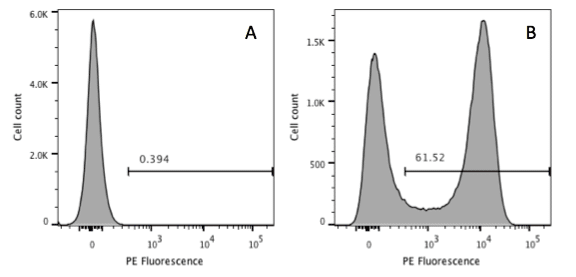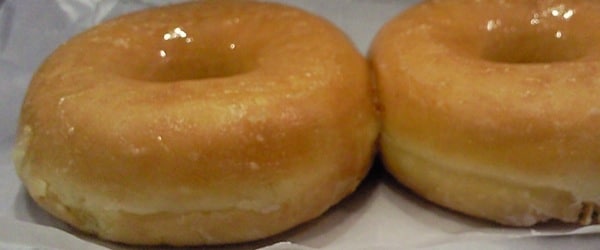Have you ever wondered why you can detect fluorescence in your unstained microscopy sample?
This is a phenomenon known as autofluorescence.
Autofluorescence can be a nuisance. It reduces the signal-to-noise ratio, decreasing signal sensitivity, and in some cases masking a specific signal altogether.
Does this sound familiar? We’ve compiled some tips for assay optimization to help you identify and reduce the autofluorescence in your sample.
What is Autofluorescence?
The term autofluorescence refers to any background fluorescence that occurs in cells or tissues that have not been stained with a specific fluorescent marker.
It’s caused primarily by metabolites and cellular structures that serve as natural fluorophores within the cell.
Common Autofluorescent Molecules
In mammalian cells, common autofluorescent molecules include:
- NADH
- Collagen
- Elastin
- Aromatic amino acids such as tryptophan.
- Lipofuscins
- flavins
- Porphyrins and porphyrin-containing molecules
In addition to many of the above, bacteria also contain autofluorescent molecules, such as:
- Chlorophyll
- Bacteriochlorophyll
- Pigmented Secondary Metabolites
- Retinal proteins such as bacteriorhodopsin
In plant cells, chlorophyll and lignin are common fluorescent molecules.
What is Fluorescence? A Quick Reminder
Fluorescence occurs when a molecule absorbs a photon of light, transitioning from its resting state into an excited state. After a few nanoseconds, the molecule relaxes back to a lower-energy resting state, releasing a lower-energy photon of light at a longer wavelength, which we can detect as fluorescence.
The excitation and emission wavelengths are specific for each molecule. Aromatic side chains and cyclic ring structures are more likely to fluoresce due to the easily excitable electrons in the conjugated ring systems.
Check out this article to learn more about how fluorescent molecules work.
Autofluorescence is Tissue Dependant
To put that into context within a cell, molecules such as NADH, which has a conjugated ring system, are abundant in the cytoplasm. Because of its conjugated rings, NADH will absorb light in the 335– 350 nm range and has a broad emission peak of around 440–470 nm. [1]
The fluorescence from the NADH will overlap and potentially mask the specific signals from common green channel fluorophores, such as Alexa Fluor 488 and FITC.
The amount of autofluorescence is tissue or cell-dependent. For example, brain tissue from a late-onset neurodegenerative condition will likely contain increased levels of lipofuscin, an aging pigment, which accumulates in the lysosomes of long-living cells. [2]
Lipofuscin is autofluorescent and has a broad emission spectrum which can present challenges during sample analysis.
How Do I Know If My Sample Autofluoresces?
Make sure to include an unlabelled (non-fluorescent) control and a secondary-antibody-only control in your sample to identify any fluorescence contributions from the sample itself and your staining procedure.
If your sample fluoresces while your non-fluorescent control remains dark, your sample is probably autofluorescent.
For a guide on what controls to include in your fluorescence microscopy sample and what they tell you, download our immunofluorescence troubleshooting guide!
It may also be worth running a wavelength scan to help identify the wavelengths where the autofluorescent signal is strongest, as this could help you with assay optimization.
So, with all that said, can anything be done to reduce autofluorescence? Thankfully, the answer is yes!
Option 1: Choose an Optimal Fluorophore
The easiest solution is to use a fluorophore with an emission spectrum that does not overlap with the emission spectrum of the molecule causing the autofluorescence.
For example, the majority of autofluorescence in mammalian cells occurs in the blue/green channel. Therefore, using a fluorophore with an emission spectrum in the red and far-red regions will increase the specificity of the signal and avoid the contributions from the autofluorescence.
Read this handy article for a summary of fluorescent proteins you can choose from.
Consider Using a Brighter Fluorophore
Depending on the nature of the experiment, it may not be possible to use a fluorophore with an emission spectrum that is separate from that of the autofluorescence. This can be true in many situations, such as in multiplexing experiments.
Therefore, using a really bright fluorophore will increase your true (non-autofluorescent) signal and, therefore, increase the signal-to-noise ratio. In ambiguous cases where you are unsure what is your true signal and what is autofluorescence, using a bright fluorophore can help you identify your desired signal.
Tip: Look for fluorophores that have a high extinction coefficient number and a quantum yield that is close to 1.
Option 2: Check Your Media
Another thing to check is the medium your cells are in. Are there any compounds that could be contributing to the autofluorescence?
Cell media usually contains various supplements such as amino acids, carbohydrates, and hormones required for maintaining cell metabolism.
Two of the most common media supplements are fetal bovine serum (FBS), and phenol red.
FBS provides cells with the essential nutrients and hormones required for cell growth.
Phenol red is a pH indicator and is often included as a quick check for the health of a cell culture.
Both of these supplements contain high numbers of molecules with aromatic side chains and will contribute to increased levels of background fluorescence.
Reducing the FBS concentration and switching to a media like RPMI or a saline-based solution will go a long way in reducing autofluorescence if your cells will tolerate it.
Option 3: Sample Preparation Optimisation
Fixative reagents contribute to autofluorescence. Common examples include:
- Glutaraldehyde
- Paraformaldehyde
- Formaldehyde
Using the fixatives for the minimum time possible or switching to a non-aldehyde-based fixative such as chilled ethanol (used at -20oC), will help with reducing background fluorescence.
It is also important to consider the biological makeup of your sample.
For example, hemoglobin autofluoresces (because of the porphyrin ring) across a broad emission spectrum and it would likely interfere with sample analysis.
If red blood cells are present in your sample, it may be useful to rinse samples with PBS to remove the red blood cells and reduce the fluorescent contributions from the haem groups.
Option 4: Chemical Treatment to Reduce Autofluorescence
If you have considered the above options and are still encountering some troublesome autofluorescence, then chemical treatments may be necessary to attenuate the background signal.
Treatments with commercially available reagents such as Sudan black B and sodium borohydride could be an option for reducing autofluorescence following sample fixation. [3]
Try Sudan Black B
This is a non-fluorescent stain that will quench autofluorescence from biological lipids and other types of molecules within cells.
It is particularly effective in neutralizing the autofluorescence from elastic fibers, lipofuscins, and some other lipids.
It selectively absorbs the excitation light that would otherwise cause autofluorescence and therefore reduces the background fluorescence.
Or Sodium Borohydride
This is a reducing agent that can decrease autofluorescence caused by aldehydes formed during the fixation of samples, particularly with formaldehyde or glutaraldehyde.
Aldehydes can react with proteins and other cellular components to form Schiff bases which are fluorescent.
Sodium borohydride reduces these aldehyde groups to alcohols, reducing their ability to fluoresce.
If you go down this route, check your sample can tolerate these chemicals, particularly sodium borohydride.
Option 5: Photobleaching
Photobleaching is normally something to avoid when it comes to fluorescence microscopy.
However, in the case of autofluorescence, photobleaching could be the key to unlocking the signal you’re looking for.
Applying a high-intensity LED light to your sample before adding your fluorophores can bleach the sample and reduce the background fluorescence, boosting the signal generated by your chosen fluorophores.
Option 6: Advanced Spectral Analysis
Finally, should all else fail, it may be possible to optimize your signal using microscope settings and analysis software. Have a look at the advanced options available in your microscope setup and analysis software.
Techniques such as spectral unmixing, if used carefully, can isolate the autofluorescent signal and subtract it.
Alternatively, more complex imaging techniques such as fluorescence lifetime imaging (FLIM) may be worth exploring if autofluorescence is still plaguing your experiments. The signal from FLIM is independent of the concentration of the fluorophore, which could solve your problems. The signal also depends on the microenvironment of the fluorophore and is sensitive to any changes in it.
Overcoming Autofluorescence in Summary
That was a quick summary of autofluorescence, why it happens, and how to avoid it!
Choosing an optimal fluorophore and culture media from the outset of your experiments can save you loads of time troubleshooting autofluorescence later. If it’s still an issue, you can try changing up your sample fixative or photobleaching your sample.
If you found this article helpful or have other strategies to reduce autofluorescence, let us know in the comments section below.
References
1. Cannon TM, Lagarto JL, Dyer BT, Garcia E, Kelly DJ, Peters NS, Lyon AR, French PMW, Dunsby C. (2021). Characterization of NADH fluorescence properties under one-photon excitation with respect to temperature, pH, and binding to lactate dehydrogenase. OSA Contin. 4(5):1610–25
2. Moreno-García A, Kun A, Calero O, Medina M, Calero M. (2018). An Overview of the Role of Lipofuscin in Age-Related Neurodegeneration. Front Neurosci. 12:464
3. Baschong W, Suetterlin R, Laeng RH. (2001). Control of autofluorescence of archival formaldehyde-fixed, paraffin-embedded tissue in confocal laser scanning microscopy (CLSM). J Histochem Cytochem. 49(12):1565–72







